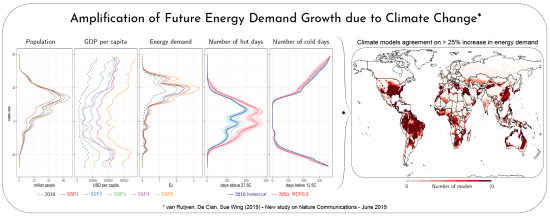
The world is dependent on energy both for human wellbeing and society’s continued development. Energy use is however also one of the human systems that is most directly influenced by changes in climate, which makes it crucial to gain insight into the impacts of climate change on energy demand.
Most previous studies explored this topic for a single country or continent, or for a single sector (mostly households). In addition, researchers only employed climate projections from either a single, or just a few climate models.
In this new study, the authors did a global analysis using temperature projections from 21 climate models, and population and economy projections for five socioeconomic scenarios. This information was fed into a statistical model to calculate changes in demand for three fuels and four economic sectors, to determine how energy demand would shift relative to today’s climate under modest and high-warming scenarios around 2050.

The findings indicate that, compared to baseline scenarios in which energy demand is driven by population and income growth alone, climate change increases the global demand for energy around 2050 by 11-27% with modest warming, and 25-58% with vigorous warming.
Large areas of the tropics, as well as southern Europe, China, and the USA, are likely to experience the highest increases. The largest changes in demand are due to electricity needed for cooling, and occur in the industry and service sectors of the economy.
The magnitude of the increase depends on three uncertain factors:
the future pathways of global greenhouse gas emissions;
the different ways that climate models use this information to project future hot and cold temperature extremes in various world regions; and
the manner in which countries’ energy consumption patterns change under different scenarios of future increases in population and income.
An important way in which society will adapt to rising temperatures from climate change is by increasing cooling during hot seasons and decreasing heating during cold seasons. Changes in space conditioning directly impact energy systems, as firms and households demand less natural gas, petroleum, and electricity to meet lower heating needs, and more electricity to satisfy higher cooling needs.
—coauthor Enrica de Cian from the Ca’ Foscari University of Venice and the Euro-Mediterranean Center on Climate Change (CMCC)
Whether future warming will cause the demand for energy to increase or decrease is a crucial question. If energy use rises and leads to additional emissions of heat-trapping greenhouse gases, increased energy consumption for space conditioning could make it more difficult and costly to mitigate future warming. Quantifying this risk requires understanding how the demand for energy by different types of consumers in different climates will be affected by warming. The results of our study can in the future be used to calculate how energy market dynamics will ultimately determine changes in energy consumption and emissions.
—coauthor Ian Sue Wing, a researcher at Boston University
According to the authors, an important qualification is that the study’s findings represent the initial impacts of global warming. They do not account for the additional adjustments in fuel supplies and prices, and subsequent substitution responses by producers and consumers across the world that impacts will trigger. While these forces are likely to lead to ultimate changes in energy consumption that are less extreme, they also incur adaptation costs that will affect the broader economy and household incomes.
The lower the level of income per person, the larger the share of income that families need to spend to adapt to a given increase in energy demand. Some scenarios in our study assume continued population growth and in those cases temperature increases by 2050 could expose half a billion people in the lowest-income countries in the Middle-East and Africa to increases in energy demand of 25% or higher. The poor face challenges to adaptation that are not only financial—in areas that have unreliable electricity supplies, or lack grid connections altogether, increased exposure to hot days increases the risk of heat-related illnesses and mortality.
—lead author Bas van Ruijven, a researcher with the IIASA Energy Program







